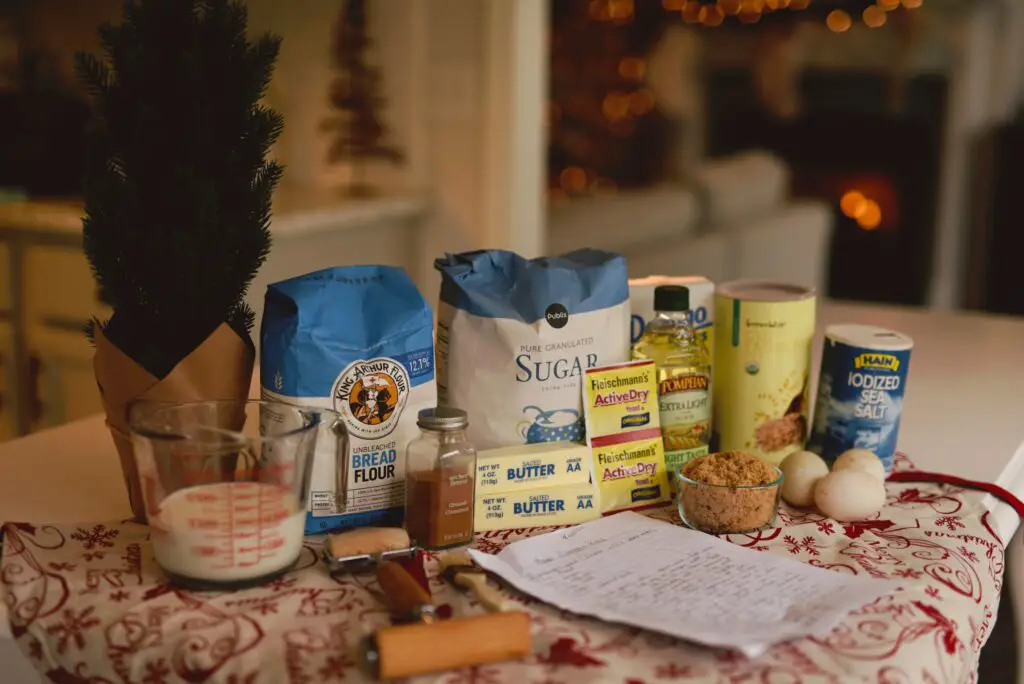We’ve all been there—halfway through mixing a cake when you realize the sugar canister is empty. Instant panic, right?
Here’s the good news: you don’t always need to toss the bowl and run to the store. Baking is more flexible than it looks, and the right swap can save your recipe (and your mood).
In this post, you’ll find simple substitutions for flour, sugar, fats, dairy, eggs, and even leavening agents—so you can keep baking without missing a beat.
Flour Substitutions
All-Purpose Flour → Cake or Bread Flour Adjustments
Running out of all-purpose flour doesn’t mean the recipe is doomed. Cake flour can step in, but you’ll need to adjust. Cake flour is softer and has less protein, which means it creates tender bakes like sponge cakes.
To make it behave more like all-purpose, simply add 2 extra tablespoons of cake flour per cup. On the flip side, bread flour has more protein, giving you a chewy texture and extra structure.
If that’s all you’ve got, use a cup minus 2 teaspoons to avoid toughness.
Think of it like swapping shoes—cake flour is the comfy slipper, bread flour is the sturdy work boot, and all-purpose sits happily in the middle.
Gluten-Free Options
No wheat? No problem—as long as you know what to expect. Almond flour adds a nutty flavor and a slightly dense texture, perfect for cookies and quick breads.
Oat flour (which you can make by blending rolled oats) gives baked goods a wholesome, slightly chewy quality—great for muffins and pancakes.
Rice flour is lighter but can feel a little gritty unless mixed with starches like cornstarch or tapioca.
The key with gluten-free swaps is balance: mix and match flours, and don’t expect a one-to-one identical copy of the original. Texture will shift, but flavor can shine.
DIY Self-Rising Flour
Many recipes call for self-rising flour, and if you don’t keep it on hand, making your own is quick. For every cup of all-purpose flour, add 1 ½ teaspoons of baking powder and ¼ teaspoon of salt. That’s it.
You’ve just created a blend that lifts your cakes and biscuits without needing extra steps.
Bonus: homemade self-rising flour is fresher and more reliable since you know exactly what went in. Keep this trick in your back pocket, and you’ll never feel stuck when a recipe springs it on you at the last minute.
Sugar Substitutions
White Sugar → Brown Sugar (and vice versa)
If you’ve only got brown sugar when a recipe calls for white, don’t sweat it. Brown sugar has molasses, which makes baked goods moister and adds a caramel-like flavor.
Using it instead of white sugar will give your cookies or cakes a deeper taste and a chewier bite. Flip it the other way, and swapping white for brown means you’ll lose that rich note, but the recipe will still hold up.
In a pinch, you can even make your own brown sugar by mixing white sugar with a spoonful of molasses. Problem solved.
Liquid Sweeteners: Honey, Maple Syrup, Agave
Liquid sweeteners bring both flavor and moisture. Honey is bold and floral, maple syrup is earthy and distinct, and agave is light with a clean sweetness.
When using them instead of sugar, reduce the other liquids in your recipe by about 3 tablespoons for each cup of sweetener added.
Also, lower your oven temperature slightly, since liquid sugars tend to brown faster. Think of them as double-duty ingredients: sweetener and flavor enhancer in one.
Powdered Sugar: Blitz Granulated Sugar in a Blender
Out of powdered sugar and need it for frosting or glaze? Toss granulated sugar into a blender or food processor and blitz until it’s fine and powdery.
Add a little cornstarch if you want it to store well and not clump. It won’t be as perfectly smooth as store-bought, but it works like a charm for quick fixes.
It’s one of those “kitchen magic” tricks that makes you feel like a pro.
Sugar-Free Options: Stevia, Monk Fruit
For anyone cutting back on sugar, stevia and monk fruit are solid options. They’re intensely sweet, so you’ll only need a small amount—too much can leave an aftertaste.
These sweeteners shine in recipes where sugar isn’t providing structure, like beverages or frostings. In cookies or cakes, the texture might change since sugar also adds bulk and helps with browning.
They’re best used thoughtfully, with the understanding that the end result won’t taste exactly like the original—but it will still be sweet enough to satisfy.
Fat Substitutions
Butter → Margarine, Coconut Oil, or Shortening
Butter is a flavor powerhouse, but if you’re out, you’ve got options. Margarine works almost one-to-one, though it won’t always deliver the same rich taste.
Coconut oil is a clever swap in cookies and cakes—it adds a light sweetness and can even bring a hint of coconut if you use the unrefined kind.
Shortening, while not the healthiest, creates extra-tender and flaky pastries because it melts differently than butter.
Just remember: butter adds both fat and flavor, so any swap will change the taste slightly.
Think of butter as the lead singer—your replacement might hit the notes, but the concert feels a little different.
Healthier Swaps: Applesauce, Mashed Banana, Greek Yogurt
If you’re aiming for a lighter bake, these healthier stand-ins do double duty. Applesauce is a classic: it adds moisture without extra fat, making cakes and muffins soft and fluffy.
Mashed banana works the same way, but brings its own flavor—perfect if you don’t mind a banana undertone in brownies or pancakes. Greek yogurt adds creaminess and tang while lowering fat content.
These swaps are great when the goal isn’t just to replace butter but to create a lighter version of your favorite treat.
Pro tip: Start by replacing only half the fat with these options to keep texture and taste balanced.
Oil Types: Vegetable, Olive, Avocado
Oil is another baking staple, and the type you use can subtly change the outcome. Vegetable oil is the most neutral—it disappears into the recipe and just does its job.
Olive oil adds a fruity note that works beautifully in bread, cakes with citrus, or chocolate desserts. Avocado oil is mild and brings healthy fats without overpowering the flavor.
If a recipe calls for butter but you only have oil, it’ll still work, but expect a moister, slightly denser result. It’s like swapping sneakers for hiking boots—you’ll still get where you’re going, but the feel is different.
Dairy Substitutions
Milk → Water, Plant-Based Milks (Almond, Oat, Soy, Coconut)
No milk in the fridge? Water can save you in simple recipes like bread or pancakes, though the flavor will be plainer. If you’ve got plant-based options, even better.
Almond milk is light and slightly nutty, oat milk is creamy and neutral, soy milk brings protein and body, and coconut milk adds richness with a tropical twist. Most of these swap one-to-one with regular milk.
Just keep in mind that flavored or sweetened versions will sneak extra sugar into your recipe—sometimes a win, sometimes not.
Buttermilk → Milk + Lemon Juice or Vinegar
Buttermilk gives tang and tenderness to biscuits, pancakes, and cakes. Luckily, you can whip up a quick substitute in two minutes flat.
Mix one cup of milk with a tablespoon of lemon juice or vinegar and let it sit until it curdles slightly. That’s it—you’ve made faux buttermilk.
The acid activates baking soda, which helps your recipe rise and taste lighter. It’s one of those swaps that feels like a little kitchen chemistry experiment.
Heavy Cream → Milk + Butter, or Evaporated Milk
Heavy cream is rich, thick, and sometimes crucial for texture. If you don’t have it, combine ¾ cup milk with ¼ cup melted butter to mimic the fat content.
This works best for sauces and baking, where cream adds richness but not necessarily whipped volume. For a lighter option, evaporated milk can step in—it’s concentrated and creamy, though not as thick.
Just don’t try to whip it like you would cream; you’ll only end up with disappointment and a sore arm.
Yogurt → Sour Cream (and vice versa)
Yogurt and sour cream are practically cousins in the dairy family. Both add moisture and a slight tang, and they swap easily in cakes, muffins, or dips.
Greek yogurt works especially well because it’s thicker, closer in texture to sour cream. Sour cream, on the other hand, adds a little more fat and smoothness.
The rule of thumb is simple: if your recipe calls for one and you’ve only got the other, go ahead and swap. You might notice a small flavor shift, but the bake will still come out delicious.
Egg Substitutions
For Binding: Flaxseed Meal + Water, Chia Seeds, Mashed Banana
Eggs often act as the glue that holds your bake together. A simple “flax egg” does the trick: mix 1 tablespoon of ground flaxseed with 3 tablespoons of water and let it sit until it thickens.
Chia seeds work the same way, creating a gel that mimics the stickiness of an egg. If you prefer something more flavorful, mashed banana adds both binding power and sweetness.
Just know your brownies or muffins might carry a hint of banana, which can be a happy accident if you love the taste.
For Leavening: Baking Soda + Vinegar, Carbonated Water
Sometimes eggs are there to give lift and fluffiness. A mix of 1 teaspoon of baking soda with 1 tablespoon of vinegar creates bubbles that help the dough rise, similar to how eggs trap air.
It’s especially handy in quick breads and cupcakes. Another sneaky option is carbonated water—swap out a quarter cup of liquid for fizzy water, and you’ll be surprised at how light your batter becomes.
It’s like giving your bake a little sparkling boost.
For Moisture: Applesauce, Yogurt, Pumpkin Puree
Eggs also bring moisture, keeping cakes soft instead of crumbly. Unsweetened applesauce is the classic go-to—it blends smoothly and adds subtle sweetness.
Yogurt works too, bringing both creaminess and tang. Pumpkin puree is another smart swap, especially in fall baking, where its flavor blends seamlessly with warm spices.
Each of these substitutions keeps your baked goods tender, but they may slightly shift the taste. That’s not necessarily a bad thing—it’s more like giving your recipe a seasonal or fruity twist.
Leavening Substitutions
Baking Powder → Baking Soda + Cream of Tartar
Baking powder is basically baking soda with an acid already mixed in. If you’re out, you can whip up your own with pantry basics.
Combine ¼ teaspoon of baking soda with ½ teaspoon of cream of tartar to equal one teaspoon of baking powder.
This works because the acid in the cream of tartar balances the alkaline soda, creating the bubbles that make your cakes and cookies rise.
No cream of tartar? Lemon juice or vinegar can pinch-hit, though the flavor may be a little tangier.
Baking Soda → Use More Baking Powder (If Recipe Allows)
Baking soda is powerful stuff—about three to four times stronger than baking powder. If you’re missing it, you can use more baking powder, but you’ll need to triple the amount to get a similar effect.
Keep in mind that baking powder already has acid mixed in, so your recipe may taste a bit different.
This swap works best in recipes that don’t heavily rely on soda for that big, dramatic rise—think muffins or quick breads. For cookies, it’ll still work, but you may notice they spread less.
Yeast → Baking Powder or Soda (Quick Breads Only, Not Exact)
Yeast is a whole different beast—it’s alive, and it needs time to work. If you’re baking bread and you don’t have yeast, there’s no perfect swap.
But you can still make a “quick bread” by using baking powder or baking soda instead.
These chemical leaveners don’t need proofing time, so your loaf will bake faster, but the flavor and texture won’t be the same. Expect more of a muffin or soda bread vibe rather than a chewy, airy yeast loaf.
It’s not a perfect trade, but when you’re craving homemade bread without yeast, it’s a lifesaver.
Flavor Boosters & Extras
Vanilla Extract → Almond Extract, Maple Syrup, or Bourbon
Vanilla is the unsung hero of baking—it quietly makes everything taste better. But if the bottle’s empty, don’t panic. Almond extract adds a bold, nutty kick, so use it sparingly (a little goes a long way).
Maple syrup works as a sweet, mellow stand-in, especially in cookies, muffins, or pancakes. Feeling adventurous? A splash of bourbon brings warmth and depth without turning your bake into a cocktail.
Each option changes the personality of your dessert, but sometimes that’s where the fun begins.
Chocolate Chips → Chopped Chocolate Bars, Cocoa Nibs, or Dried Fruit
No chocolate chips? Grab a chocolate bar and chop it into chunks—bonus points for those gooey pools of melted chocolate you get instead of uniform chips.
Cocoa nibs are crunchier and less sweet, great if you want a more grown-up vibe in cookies. If chocolate isn’t around at all, dried fruit like cranberries, raisins, or cherries adds chewiness and bursts of flavor.
It’s a twist that might just make people ask for your “secret ingredient.”
Spices → Cinnamon ↔ Nutmeg, Allspice, or Ginger
Spices are like the personality of your bake, and they can swap around more than you’d think. Cinnamon gone? Nutmeg brings warmth, allspice gives a slightly peppery depth, and ginger adds zing.
The reverse works too—if a recipe calls for nutmeg or allspice, cinnamon usually steps in just fine. Each spice carries its own mood: cinnamon is cozy, nutmeg is sophisticated, and ginger is lively.
Switching them up can change the story your dessert tells, but it’s rarely a bad story.
Tips for Successful Substitutions
Consider the Role of the Ingredient
Every ingredient in baking has a job. Flour builds structure, sugar sweetens but also helps with browning, eggs can bind or lift, and fats keep things tender.
Before swapping, ask yourself: what is this ingredient actually doing here? If you know the role, it’s easier to choose the right replacement.
For example, applesauce can replace butter for moisture, but it won’t add the same richness of flavor. Understanding the “why” keeps your substitutions smart instead of random.
Adjust Quantities of Liquid and Dry to Balance Texture
Swapping one thing for another often changes the moisture level. Honey is wetter than sugar, yogurt is heavier than milk, and bananas bring both thickness and flavor.
That means you may need to tweak the liquids or dry ingredients to keep the batter balanced. Too wet? Add a spoonful of flour. Too dry? Splash in a bit more milk or water.
Expect Slight Flavor and Texture Differences
Let’s be real—no swap is truly invisible. Brown sugar makes cookies chewier, olive oil adds a fruity note, and flax eggs won’t give you the same lift as the real deal. And that’s okay.
Part of baking is rolling with the changes and enjoying the surprises. Sometimes the difference becomes your new favorite version. Other times, you chalk it up as a lesson learned.
Either way, you’re still getting something warm and homemade out of the oven.
When in Doubt: Test Small Batches First
Not sure how a substitution will behave? Don’t risk an entire cake on a guess. Make a half batch or even a single muffin or cookie as a test run.
That way, if the swap doesn’t work as expected, you haven’t wasted a mountain of ingredients. It’s a small step that saves time, money, and frustration.
Plus, you get a mini snack while you experiment—never a bad thing.
Final Words
Substitutions aren’t setbacks—they’re chances to get creative and resourceful in the kitchen. Baking doesn’t need perfection to be delicious; it just needs a little flexibility.
So the next time you’re missing an ingredient, don’t panic. Swap smart, keep baking, and enjoy the surprise twist. Try one substitution this week and see what new favorite you might stumble into.
FAQs
Can I always substitute one ingredient for another?
Not always. It depends on the role that ingredient plays—structure, flavor, or moisture. Some swaps work seamlessly, while others may change the outcome entirely.
Will substitutions change baking times?
Sometimes. Ingredients that add more moisture or density can slow baking, while lighter substitutions may shorten it. Keep an eye on color, texture, and doneness cues instead of just the clock.
Are vegan substitutions reliable for all recipes?
They can be, but results vary. Flax eggs or plant-based milks work great in many recipes, but delicate bakes like meringues or soufflés rely heavily on eggs and may not turn out the same.
What’s the best substitute for butter in cookies?
Coconut oil is a strong choice for texture, while margarine gives a closer flavor match. For a healthier twist, try half applesauce and half butter substitute—it keeps cookies soft but still tasty.
Can I mix multiple substitutions in one recipe?
Yes, but tread lightly. Too many swaps at once can make a recipe unpredictable. If you’re experimenting, start with one or two changes so you can track what works and what doesn’t.



